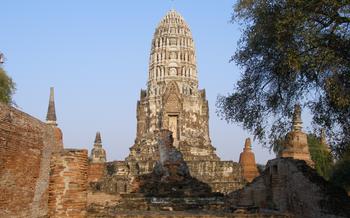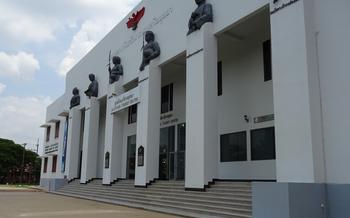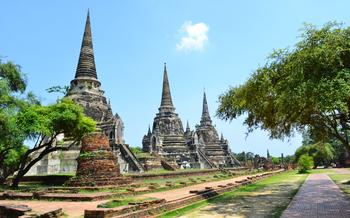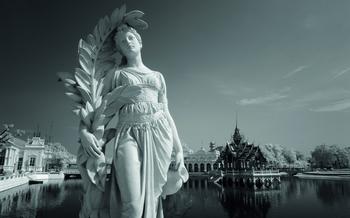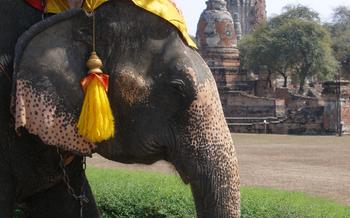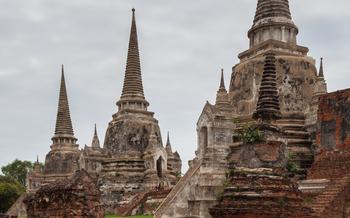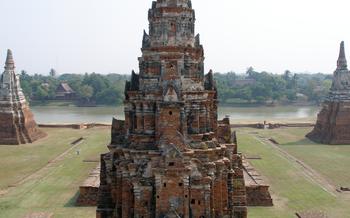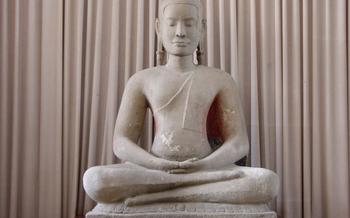
The Royal Palace (Ayutthaya)
- The Royal Palace (Ayutthaya): A Majestic Historical Site
- Exploring the Palace Grounds
- The Throne Halls: Symbols of Power
- The Royal Residences: A Glimpse into the Past
- The Temples and Religious Structures
- Gardens and Courtyards: A Serene Oasis
- The Royal Barges: A Majestic Display
- The Museum of Ayutthaya History
- Wat Mahathat: A Sacred Buddhist Temple
- Wat Chaiwatthanaram: A Unique Khmer-Style Temple
- Wat Yai Chai Mongkhon: A Majestic Reclining Buddha
- Insider Tip: Exploring Ayutthaya by Bicycle
The Royal Palace (Ayutthaya): A Majestic Historical Site
The Royal Palace in Ayutthaya, Thailand, stands as a testament to the grandeur and magnificence of the ancient Siamese kingdom. Built in the 14th century, the palace served as the seat of power for over 400 years, housing the royal family and hosting grand ceremonies and official functions. Its strategic location on an island surrounded by three rivers, the Chao Phraya, Lopburi and Pa Sak, provided natural protection and reinforced its importance as a political and cultural center.
The palace complex encompasses a vast area, featuring an array of structures, including throne halls, royal residences, temples, gardens, and courtyards, each reflecting the exquisite craftsmanship and architectural prowess of the Ayutthaya period. The palace's design incorporates traditional Thai elements, such as intricate carvings, colorful murals, and towering stupas, showcasing the kingdom's rich artistic heritage.
Exploring the Palace Grounds
The Royal Palace complex encompasses a sprawling array of structures and spaces, each with its own unique significance and charm. Visitors can embark on a captivating journey through history as they explore the various throne halls, royal residences, temples, and gardens that make up this architectural masterpiece.
Among the highlights of the palace complex are the majestic throne halls, where the kings of Ayutthaya once conducted their royal ceremonies and received foreign dignitaries. These grand structures showcase exquisite architecture and intricate detailing, reflecting the power and prestige of the monarchy.
The royal residences, once home to the royal family, offer a glimpse into the private lives of the kings and queens of Ayutthaya. These elegant buildings feature beautiful interiors, adorned with intricate murals and opulent furnishings, providing a glimpse into the grandeur and opulence of the royal court.
The palace grounds also boast several temples and religious structures, reflecting the deep-seated Buddhist faith of the Ayutthaya people. These sacred spaces are adorned with intricate carvings, colorful murals, and towering stupas, creating a serene and spiritual atmosphere.
Visitors can wander through the tranquil gardens and courtyards, which offer a respite from the hustle and bustle of the city. These verdant spaces are adorned with lush greenery, fragrant flowers, and serene ponds, creating a peaceful oasis amidst the grandeur of the palace complex.
The Throne Halls: Symbols of Power
The throne halls within the Royal Palace (Ayutthaya) stand as majestic symbols of power and authority. These grand structures, adorned with intricate carvings and adorned with gold leaf, served as the stage for royal ceremonies, official functions, and the administration of justice.
The most prominent throne hall is the Throne Hall of Dusit Maha Prasat, also known as the Grand Palace. Built in the 17th century, this awe-inspiring structure features a towering spire and a spacious interior that could accommodate hundreds of courtiers and officials. The throne hall was used for grand ceremonies, such as the coronation of kings and the reception of foreign dignitaries.
Another significant throne hall is the Throne Hall of Chantharakasem, which served as the royal court and the place where the king held daily audiences. This throne hall is smaller in size but equally impressive in its architectural details. Its walls are adorned with exquisite murals depicting scenes from Thai history and mythology.
The Throne Hall of Amarindra Vinichai is a relatively smaller throne hall that was used for private audiences and meetings. It features a beautiful ceiling adorned with intricate paintings and a raised platform where the king would sit.
These throne halls not only served as functional spaces for royal ceremonies but also reflected the grandeur and authority of the Ayutthaya Kingdom. Visitors can explore these architectural masterpieces and imagine the grandeur and opulence that once filled these halls.
The Royal Residences: A Glimpse into the Past
The royal residences within the palace complex offer a fascinating glimpse into the lifestyle and customs of the Thai royal family throughout history. These residences, which were once home to kings, queens, and their entourage, showcase a blend of traditional Thai architecture and modern amenities. Visitors can explore the various rooms, including private chambers, audience halls, and reception areas, each adorned with intricate carvings, murals, and furnishings that reflect the grandeur and opulence of the royal court.
The Wichai Prasat Throne Hall, located within the palace grounds, served as the official residence of the king during the Ayutthaya period. This grand structure, with its towering spires and intricate decorations, was the center of royal life, where important ceremonies, meetings, and receptions were held. The throne hall features a spacious audience chamber, adorned with opulent furnishings and a majestic throne, where the king received foreign dignitaries and conducted state affairs.
Another significant royal residence is the Suriyat Amarin Throne Hall, which was built during the reign of King Narai. This elegant structure, with its graceful lines and delicate ornamentation, was used as a summer palace and a place for royal entertainment. The throne hall features a large central hall, surrounded by smaller chambers and verandas, offering stunning views of the palace gardens and the surrounding landscape.
These royal residences provide a unique opportunity to step back in time and experience the grandeur and opulence of the Thai monarchy. Visitors can wander through the rooms, imagining the lives of the kings, queens, and courtiers who once inhabited these spaces, and gain a deeper understanding of the rich history and traditions of the Thai royal court.
The Temples and Religious Structures
The Royal Palace in Ayutthaya is not only a testament to the kingdom's political power but also a sacred space adorned with numerous temples and religious structures. These temples served as centers of worship and spiritual guidance for the royal family and the people of Ayutthaya. The most prominent temple within the palace grounds is Wat Phra Si Sanphet, which was the royal temple and the most important religious site in the kingdom. This temple complex boasts three towering prang towers and a series of smaller stupas, exuding an aura of grandeur and spirituality.
Other notable temples within the palace grounds include Wat Mahathat, known for its iconic Buddha head entwined by tree roots, and Wat Chaiwatthanaram, which showcases a unique Khmer-style architecture. These temples, along with the numerous smaller shrines and stupas scattered throughout the palace complex, provide a glimpse into the deep-rooted Buddhist beliefs and practices that shaped the kingdom of Ayutthaya.
It is important to remember that these temples are not just historical relics but active religious sites, and visitors are expected to dress and behave respectfully. While exploring these sacred spaces, visitors can immerse themselves in the spiritual traditions of Thailand and gain a deeper understanding of the role that Buddhism played in the kingdom's history and culture.
Gardens and Courtyards: A Serene Oasis
Amidst the grandeur and historical significance of the Royal Palace, the gardens and courtyards offer a tranquil escape, inviting visitors to immerse themselves in nature's embrace. These serene spaces, meticulously designed and carefully maintained, provide a refreshing contrast to the opulent architecture of the palace buildings.
The gardens are a testament to the artistic vision and horticultural expertise of the palace's designers. Verdant lawns, adorned with colorful flowerbeds and exotic plants, create a vibrant tapestry of colors and textures. Majestic trees, their branches reaching towards the sky, provide shade and shelter from the tropical sun.
Water features, such as ponds, fountains, and canals, add an element of tranquility and serenity to the gardens. The gentle sound of water flowing creates a soothing ambiance, while the reflection of the palace buildings in the mirror-like surfaces adds a touch of magic to the surroundings.
The courtyards, enclosed by elegant colonnades and intricate latticework, offer a more intimate setting for relaxation and contemplation. These spaces, often adorned with sculptures, fountains, and decorative tiles, provide a glimpse into the refined aesthetic sensibilities of the palace's inhabitants.
Historically, the gardens and courtyards served as places of leisure and recreation for the royal family and their guests. They were used for strolling, relaxing, and entertaining, offering a respite from the formal and ceremonial aspects of court life. Today, these serene spaces continue to provide visitors with a tranquil oasis, inviting them to slow down, appreciate the beauty of nature, and connect with the rich history of the Royal Palace.
The Royal Barges: A Majestic Display
Thailand's rich cultural heritage is showcased in the opulent royal barges that once transported royalty along the waterways of Ayutthaya. These magnificent vessels, adorned with intricate carvings, gold leaf, and colorful decorations, served as a symbol of power and prestige during the Ayutthaya Kingdom.
The royal barges, constructed from the finest woods and manned by skilled oarsmen, were not mere means of transportation but also works of art. Each barge had a unique design and purpose, with some reserved for the king and queen, while others were used for royal processions and ceremonies.
One of the most famous royal barges, the Suphannahong, or "Golden Swan," is a testament to the kingdom's craftsmanship and artistry. This majestic vessel, measuring over 40 meters in length, is adorned with intricate carvings depicting mythical creatures, delicate floral motifs, and gleaming gold leaf.
The royal barges played a pivotal role in royal ceremonies and events. During the annual Water Procession, the king and queen would embark on a grand procession along the river, accompanied by a flotilla of elaborately decorated barges. These processions were a spectacle of music, dance, and colorful displays, showcasing the splendor and opulence of the Ayutthaya court.
Today, visitors can admire these magnificent vessels at the Royal Barges National Museum in Bangkok. The museum houses a collection of royal barges, including the Suphannahong, which have been carefully preserved and restored to their former glory. Visitors can marvel at the intricate craftsmanship and learn about the history and significance of these royal vessels.
The Museum of Ayutthaya History
The Museum of Ayutthaya History is a treasure trove of artifacts and exhibits that provide a fascinating glimpse into the rich past of Ayutthaya. Located within the Ayutthaya Historical Park, the museum houses a vast collection of archaeological findings, ancient sculptures, pottery, and other relics that showcase the grandeur and cultural heritage of this ancient kingdom.
Step inside the museum, and you'll be greeted by a captivating display of artifacts that tell the story of Ayutthaya's rise and fall. From prehistoric tools and pottery to intricate gold jewelry and religious objects, the exhibits offer a glimpse into the everyday lives, customs, and beliefs of the people who inhabited this city centuries ago.
One of the highlights of the museum is the collection of Buddha images, ranging from small, delicate statuettes to massive, awe-inspiring sculptures. These intricate works of art showcase the exceptional craftsmanship and artistic prowess of the Ayutthaya artisans and provide insight into the deep-rooted Buddhist traditions of the kingdom.
The museum also features a section dedicated to the history of the Ayutthaya Historical Park, with informative displays and maps that explain the significance of each temple and ruin. It's a great place to learn more about the park's history and plan your exploration accordingly.
The Museum of Ayutthaya History is a valuable resource for anyone interested in delving deeper into the rich cultural heritage of this ancient city. Whether you're a history buff, an art enthusiast, or simply curious about the past, the museum offers a rewarding and educational experience.
Wat Mahathat: A Sacred Buddhist Temple
Wat Mahathat, situated in the heart of the Ayutthaya Historical Park, stands as a testament to the grandeur and spiritual significance of the ancient Siamese kingdom. This majestic Buddhist temple, constructed in the 14th century, served as a royal temple and a center for religious ceremonies and teachings.
The architectural design of Wat Mahathat reflects the quintessential characteristics of Ayutthayan architecture, featuring a blend of Khmer and Sri Lankan influences. The temple complex comprises a series of stupas, ordination halls, and viharas arranged around a central courtyard. The most iconic feature of Wat Mahathat is the renowned Buddha head entwined by the roots of a bodhi tree, a poignant symbol of the harmonious coexistence between nature and spirituality.
Wat Mahathat holds immense historical significance, having served as a royal temple during the Ayutthaya period. It was a place of worship, learning, and religious ceremonies for the royal family and the people of Ayutthaya. The temple witnessed numerous historical events, including royal coronations, religious festivals, and the ordination of young men into the Buddhist monkhood.
Today, Wat Mahathat remains an active Buddhist temple, attracting pilgrims and visitors from around the world. It is a place of worship, meditation, and spiritual reflection, offering a glimpse into the rich religious traditions of Thailand. The temple also serves as a significant historical site, providing insights into the grandeur and splendor of the ancient Ayutthaya kingdom.
Wat Chaiwatthanaram: A Unique Khmer-Style Temple
Wat Chaiwatthanaram stands as a testament to the cultural and religious diversity that once flourished in Ayutthaya. This magnificent temple complex, built in the 17th century, blends traditional Thai architectural elements with distinctive Khmer influences. Its most striking feature is the central prang, or spire, which rises majestically above the surrounding structures. The prang is adorned with intricate carvings and sculptures depicting mythological figures and scenes from Buddhist mythology.
The temple's design is a harmonious blend of Thai and Khmer styles. The main sanctuary features a large Buddha image flanked by smaller Buddha statues. The walls are adorned with colorful murals depicting scenes from the life of Buddha and the history of Ayutthaya. The temple grounds also house several smaller stupas and shrines, each with its own unique architectural features and religious significance.
Wat Chaiwatthanaram is not only a religious site but also a historical landmark. It played a significant role in the history of Ayutthaya, serving as a royal temple and a place of worship for the royal family. The temple complex was damaged during the Burmese invasion of Ayutthaya in the 18th century, but it has since been restored to its former glory. Today, it stands as a symbol of the cultural and religious heritage of this ancient city.
Practical Information:
- Location: Wat Chaiwatthanaram is located in the Ayutthaya Historical Park, about 2 kilometers west of the city center.
- Accessibility: The temple complex is accessible by road and by boat. Visitors can rent bicycles or tuk-tuks to explore the historical park.
- Admission Fee: There is a small admission fee to enter the Ayutthaya Historical Park, which includes access to Wat Chaiwatthanaram and other temples within the park.
- Dress Code: Visitors are expected to dress respectfully when visiting religious sites in Thailand. It is advisable to wear long pants or skirts and avoid revealing clothing.
Wat Yai Chai Mongkhon: A Majestic Reclining Buddha
Wat Yai Chai Mongkhon, located just outside the Ayutthaya Historical Park, is a must-visit destination for its awe-inspiring reclining Buddha statue. This colossal Buddha, known as the "Great Reclining Buddha" or "Phra Buddha Chai Mongkhon," is one of the largest and most impressive Buddha images in Thailand.
Constructed in the 16th century, this massive reclining Buddha measures an astonishing 42 meters in length and 8 meters in height. The serene and peaceful expression on the Buddha's face, along with the intricate details of the statue, make it a captivating sight to behold.
The reclining Buddha at Wat Yai Chai Mongkhon is not only a religious icon but also a symbol of the Ayutthaya Kingdom's artistic and cultural heritage. It represents the Buddha's entry into parinirvana, the state of ultimate peace and liberation from the cycle of rebirth.
Visitors to Wat Yai Chai Mongkhon can marvel at the sheer size and grandeur of the reclining Buddha from various angles. The temple grounds are well-maintained, allowing for a peaceful and serene atmosphere to appreciate the beauty and significance of this sacred site.
Practical Information:
- Location: Wat Yai Chai Mongkhon is situated approximately 5 kilometers east of the Ayutthaya Historical Park, near the Bang Pa-In Palace.
- Accessibility: The temple is easily accessible by tuk-tuk or bicycle from Ayutthaya city center.
- Entrance Fee: Admission to the temple is free of charge.
- Dress Code: Visitors are expected to dress respectfully when visiting the temple, covering their shoulders and knees.
Insider Tip: Exploring Ayutthaya by Bicycle
Embrace the freedom and convenience of exploring Ayutthaya's historical park on a bicycle. Several rental shops are located near the park's entrance, offering a variety of bicycles to suit different needs and preferences. Opting for a bicycle allows you to cover more ground at your own pace, immersing yourself in the tranquil ambiance and captivating ruins of the ancient city.
Plan your route in advance to make the most of your cycling adventure. Start by visiting the iconic temples of Wat Mahathat and Wat Phra Si Sanphet, marveling at their grandeur and historical significance. Venture further to explore lesser-known temples such as Wat Chaiwatthanaram and Wat Yai Chai Mongkhon, each possessing unique architectural features and religious importance.
Take advantage of the serene atmosphere to enjoy a leisurely picnic lunch amidst the ancient ruins. Pack a delicious spread of local delicacies and find a shady spot to savor your meal while soaking in the tranquility of your surroundings.
Remember to stay hydrated and protect yourself from the sun by wearing sunscreen and a hat. While cycling through the historical park, be mindful of other visitors and cyclists, sharing the paths respectfully.
Exploring Ayutthaya by bicycle offers a unique and immersive experience, allowing you to connect with the rich history and charm of this ancient city in a truly unforgettable way.
